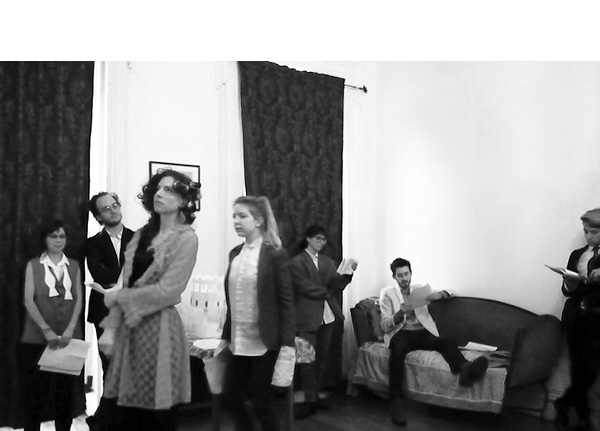
TALK BETWEEN NUDES
first performed on December 8, 2013
Page 22 / Page Poetry Parlor, New York, NY
performed once in 2013
SOPHIE SEITA
Corina Copp, Lanny Jordan Jackson, Luke McMullan, Anna Moser, Yates Norton, Emma Stirling
Brooklyn, NY / Cambridge, UK
280893612s280893612o280893612p280893612h280893612i280893612e280893612s280893612e280893612i280893612t280893612a280893612@280893612g280893612m280893612a280893612i280893612l280893612.280893612c280893612o280893612m
initialseita.wordpress.com
TALK BETWEEN NUDES
SOPHIE SEITA
First conceived as a poem, “Talk between Nudes” is a satire inspired by Tamara de Lempicka’s early paintings of vampiric and voluptuous female figures, the history of the nude in painting, rhythm, operatic composition, Greek tragedy, melodrama, the masks of comedy and the languages and gestures of affect and irony, as well as failures of communication.
The piece is about 20 minutes long and was performed as a staged reading with selectively few props (tall card crowns, card underpants, a divan, a table) and some choreographed movement (the nudes getting in shape and positioned as models to follow/please de Lempicka’s dictation). The excessive frights and desires of the characters were countered by the minimalist staging and the sometimes abstract, sometimes dated language. Blondie’s song “Heart of Glass” played from a laptop to conclude the performance while the performers read comments culled from various song lyric websites.
The play was performed in conjunction with Anna Moser’s and my joint show, in which we presented our six-month-long visual-poetic-epistolary collaboration in the form of drawings, texts, photographs, correspondence, attachments and gifts. The event was followed by a discussion with the audience.
A crucial formal problem was to balance—in performance—the disparate material and tonal shifts (of the script) between the formal precision, specificity, and artifice of the late-modernist fragmentary poetic lines the humorous use of clichés and literary tropes from early 20th century plays, and, lastly, the turn toward Greek Bacchae material. The performers had to gauge how the essentially tragic situation of the trapped nudes in a “decorous parlour,” constantly under the supervision of the extravagant and neurotic de Lempicka, would not be subsumed in surface comedy. Apart from the more direct dialogue with Anna Moser’s and de Lempicka’s paintings, the piece also has a fictional (and perhaps flirtatious) conversation with proto-dada plays, Guillaume Apollinaire, Jean Cocteau, Rochelle Owens and Kathy Acker.